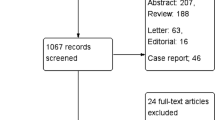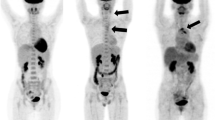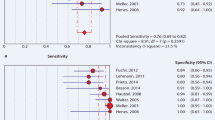Abstract
The objective of this study is to systematically review the role of positron emission tomography (PET) and PET/computed tomography (PET/CT) with fluorine-18-fluorodeoxyglucose (FDG) in patients with large-vessel vasculitis (LVV). A comprehensive literature search of published studies through April 2011 in PubMed/MEDLINE and Scopus databases regarding whole-body FDG-PET and PET/CT in patients with LVV was performed. We identified 32 studies including 604 LVV patients. The main findings of these studies are presented. The conclusions are the following: (1) FDG-PET and PET/CT are useful imaging methods in the initial diagnosis and in the assessment of activity and extent of disease in patients with LVV; (2) the correlation between FDG-PET findings and serological levels of inflammatory markers, as well as the usefulness of FDG-PET and PET/CT in evaluating treatment response, remains unclear; (3) it appears that there is a superiority of FDG-PET and PET/CT over conventional imaging methods in the diagnosis of LVV, but not in assessing disease activity under immunosuppressive treatment, in predicting relapse or in evaluating vascular complications; and (4) given the heterogeneity between studies with regard to PET analysis and diagnostic criteria, a standardization of the technique is needed.



Similar content being viewed by others
References
Arend WP, Michel BA, Bloch DA, Hunder GG, Calabrese LH, Edworthy SM et al (1990) The American College of Rheumatology 1990 criteria for the classification of Takayasu arteritis. Arthritis Rheum 33:1129–1134
Hunder GG, Bloch DA, Michel BA, Stevens MB, Arend WP, Calabrese LH et al (1990) The American College of Rheumatology 1990 criteria for the classification of giant cell arteritis. Arthritis Rheum 33:1122–1128
Healey LA (1984) Long-term follow-up of polymyalgia rheumatica: evidence for synovitis. Semin Arthritis Rheum 13:322–328
Gotthardt M, Bleeker-Rovers CP, Boerman OC, Oyen WJ (2010) Imaging of inflammation by PET, conventional scintigraphy, and other imaging techniques. J Nucl Med 51:1937–1949
Bleeker-Rovers CP, Bredie SJ, van der Meer JW, Corstens FH, Oyen WJ (2003) F-18-fluorodeoxyglucose positron emission tomography in diagnosis and follow-up of patients with different types of vasculitis. Neth J Med 61:323–329
Treglia G, Cason E, Fagioli G (2010) Recent applications of nuclear medicine in diagnostics—first part. Ital J Med 4:84–91
Treglia G, Cason E, Fagioli G (2010) Recent applications of nuclear medicine in diagnostics—second part. Ital J Med 4:159–166
Besson FL, Parienti JJ, Bienvenu B, Prior JO, Costo S, Bouvard G et al (2011) Diagnostic performance of (18)F-fluorodeoxyglucose positron emission tomography in giant cell arteritis: a systematic review and meta-analysis. Eur J Nucl Med Mol Imaging 2011 May 11. doi:10.1007/s00259-011-1830-0
Blockmans D, Maes A, Stroobants S, Nuyts J, Bormans G, Knockaert D et al (1999) New arguments for a vasculitic nature of polymyalgia rheumatica using positron emission tomography. Rheumatology 38:444–447
Blockmans D, Stroobants S, Maes A, Mortelmans L (2000) Positron emission tomography in giant cell arteritis and polymyalgia rheumatica: evidence for inflammation of the aortic arch. Am J Med 108:246–249
Meller J, Strutz F, Siefker U, Scheel A, Sahlmann CO, Lehmann K et al (2003) Early diagnosis and follow-up of aortitis with [(18)F]FDG PET and MRI. Eur J Nucl Med Mol Imaging 30:730–736
Meller J, Grabbe E, Becker W, Vosshenrich R (2003) Value of F-18 FDG hybrid camera PET and MRI in early Takayasu aortitis. Eur Radiol 13:400–405
Brodmann M, Lipp RW, Passath A, Seinost G, Pabst E, Pilger E (2004) The role of 2-18F-fluoro-2-deoxy-D-glucose positron emission tomography in the diagnosis of giant cell arteritis of the temporal arteries. Rheumatology 43:241–242
Moosig F, Czech N, Mehl C, Henze E, Zeuner RA, Kneba M, Schröder JO (2004) Correlation between 18-fluorodeoxyglucose accumulation in large vessels and serological markers of inflammation in polymyalgia rheumatica: a quantitative PET study. Ann Rheum Dis 63:870–873
Scheel AK, Meller J, Vosshenrich R, Kohlhoff E, Siefker U, Müller GA, Strutz F (2004) Diagnosis and follow up of aortitis in the elderly. Ann Rheum Dis 63:1507–1510
de Leeuw K, Bijl M, Jager PL (2004) Additional value of positron emission tomography in diagnosis and follow-up of patients with large vessel vasculitides. Clin Exp Rheumatol 22(6 Suppl 36):S21–S26
Andrews J, Al-Nahhas A, Pennell DJ, Hossain MS, Davies KA, Haskard DO, Mason JC (2004) Non-invasive imaging in the diagnosis and management of Takayasu’s arteritis. Ann Rheum Dis 63:995–1000
Webb M, Chambers A, Al-Nahhas A, Mason JC, Maudlin L, Rahman L, Frank J (2004) The role of 18F-FDG PET in characterising disease activity in Takayasu arteritis. Eur J Nucl Med Mol Imaging 31:627–634
Kobayashi Y, Ishii K, Oda K, Nariai T, Tanaka Y, Ishiwata K, Numano F (2005) Aortic wall inflammation due to Takayasu arteritis imaged with 18F-FDG PET coregistered with enhanced CT. J Nucl Med 46:917–922
Walter MA, Melzer RA, Schindler C, Müller-Brand J, Tyndall A, Nitzsche EU (2005) The value of [18F]FDG-PET in the diagnosis of large-vessel vasculitis and the assessment of activity and extent of disease. Eur J Nucl Med Mol Imaging 32:674–681
Salvarani C, Pipitone N, Versari A, Vaglio A, Serafini D, Bajocchi G et al (2005) Positron emission tomography (PET): evaluation of chronic periaortitis. Arthritis Rheum 53:298–303
Vaglio A, Greco P, Versari A, Filice A, Cobelli R, Manenti L et al (2005) Post-treatment residual tissue in idiopathic retroperitoneal fibrosis: active residual disease or silent “scar”? A study using 18F-fluorodeoxyglucose positron emission tomography. Clin Exp Rheumatol 23:231–234
Blockmans D, de Ceuninck L, Vanderschueren S, Knockaert D, Mortelmans L, Bobbaers H (2006) Repetitive 18F-fluorodeoxyglucose positron emission tomography in giant cell arteritis: a prospective study in 35 patients. Arthritis Rheum 55:131–137
Blockmans D, de Ceuninck L, Vanderschueren S, Knockaert D, Mortelmans L, Bobbaers H (2006) Repetitive 18F-fluorodeoxyglucose positron emission tomography in isolated polymyalgia rheumatica: a prospective study of 35 patients. Rheumatology 55:131–137
Nakajo M, Jinnouchi S, Tanabe H, Tateno R, Nakajo M (2007) 18F-fluorodeoxyglucose positron emission tomography features of idiopathic retroperitoneal fibrosis. J Comput Assist Tomogr 31:539–543
Blockmans D, Coudyzer W, Vanderschueren S, Stroobants S, Loeckx D, Heye S et al (2008) Relationship between fluorodeoxyglucose uptake in the large vessels and late aortic diameter in giant cell arteritis. Rheumatology 47:1179–1184
Both M, Ahmadi-Simab K, Reuter M, Dourvos O, Fritzer E, Ullrich S et al (2008) MRI and FDG-PET in the assessment of inflammatory aortic arch syndrome in complicated courses of giant cell arteritis. Ann Rheum Dis 67:1030–1033
Janssen SP, Comans EH, Voskuyl AE, Wisselink W, Smulders YM (2008) Giant cell arteritis: heterogeneity in clinical presentation and imaging results. J Vasc Surg 48:1025–1031
Bruschi M, De Leonardis F, Govoni M, Roncali M, Prandini N, La Corte R et al (2008) 18FDG-PET and large vessel vasculitis: preliminary data on 25 patients. Reumatismo 60:212–216
Hautzel H, Sander O, Heinzel A, Schneider M, Müller HW (2008) Assessment of large-vessel involvement in giant cell arteritis with 18F-FDG PET: introducing an ROC-analysis-based cutoff ratio. J Nucl Med 49:1107–1113
Henes JC, Müller M, Krieger J, Balletshofer B, Pfannenberg AC, Kanz L, Kötter I (2008) [18F] FDG-PET/CT as a new and sensitive imaging method for the diagnosis of large vessel vasculitis. Clin Exp Rheumatol 26(3 Suppl 49):S47–S52
Arnaud L, Haroche J, Malek Z, Archambaud F, Gambotti L, Grimon G et al (2009) Is (18)F-fluorodeoxyglucose positron emission tomography scanning a reliable way to assess disease activity in Takayasu arteritis? Arthritis Rheum 60:1193–1200
Lee SG, Ryu JS, Kim HO, Oh JS, Kim YG, Lee CK, Yoo B (2009) Evaluation of disease activity using F-18 FDG PET-CT in patients with Takayasu arteritis. Clin Nucl Med 34:749–752
Bertagna F, Bosio G, Caobelli F, Motta F, Biasiotto G, Giubbini R (2010) Role of 18F-fluorodeoxyglucose positron emission tomography/computed tomography for therapy evaluation of patients with large-vessel vasculitis. Jpn J Radiol 28:199–204
Piccoli GB, Consiglio V, Arena V, Pelosi E, Anastasios D, Ragni F et al (2010) Positron emission tomography as a tool for the ‘tailored’ management of retroperitoneal fibrosis: a nephro-urological experience. Nephrol Dial Transplant 25:2603–2610
Jansen I, Hendriksz TR, Han SH, Huiskes AW, van Bommel EF (2010) (18)F-fluorodeoxyglucose position emission tomography (FDG-PET) for monitoring disease activity and treatment response in idiopathic retroperitoneal fibrosis. Eur J Intern Med 21:216–221
Lehmann P, Buchtala S, Achajew N, Haerle P, Ehrenstein B, Lighvani H et al (2011) 18F-FDG PET as a diagnostic procedure in large vessel vasculitis—a controlled, blinded re-examination of routine PET scans. Clin Rheumatol 30:37–42
Pfadenhauer K, Weinerth J, Hrdina C (2011) Vertebral arteries: a target for FDG-PET imaging in giant cell arteritis? Clinical, ultrasonographic and PET study in 46 patients. Nuklearmedizin 50:28–32
Papathanasiou ND, Du Y, Menezes LJ, Al-Muhaideb A, Shastry M, Beynon H, Bomanji JB (2011) 18F-Fluorodeoxyglucose PET/CT in the evaluation of large-vessel vasculitis: diagnostic performance and correlation with clinical and laboratory parameters. Br J Radiol. doi:10.1259/bjr/16422950
Disclosures
None
Author information
Authors and Affiliations
Corresponding author
Rights and permissions
About this article
Cite this article
Treglia, G., Mattoli, M.V., Leccisotti, L. et al. Usefulness of whole-body fluorine-18-fluorodeoxyglucose positron emission tomography in patients with large-vessel vasculitis: a systematic review. Clin Rheumatol 30, 1265–1275 (2011). https://doi.org/10.1007/s10067-011-1828-9
Received:
Revised:
Accepted:
Published:
Issue Date:
DOI: https://doi.org/10.1007/s10067-011-1828-9




